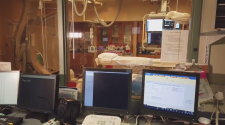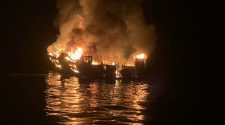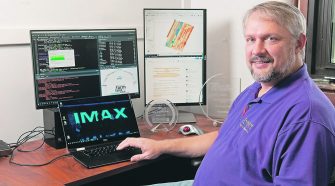By measuring the heat coming from a planet nearly 49 light-years away, astronomers were able to glean some information about the surface of the rocky world—a rare feat in exoplanet science. The observations from NASA’s Spitzer Space Telescope suggest that the exoplanet LHS 3844 b has no atmosphere, and its surface is likely covered in dark volcanic rock, making the planet similar to our moon and Mercury, according to a NASA press release.
The exoplanet, which is a “super-Earth” with about 1.3 times the radius of our planet, was discovered last year by the Transiting Exoplanet Satellite Survey (TESS) space telescope. TESS finds planets via the transit method, observing a slight dip in a star’s light when a planet passes in front from our perspective. Spitzer, an infrared telescope, was then used to take 100 hours of follow-up observations of the exoplanet and its parent star, reports Daniel Clery for Science. Those observations provided evidence that LHS 3844 b lacks an atmosphere, and measurements of the planet’s reflectivity suggest it has a dark surface of possibly basaltic rock. The findings were detailed in a study published earlier this week in Nature.
The exoplanet LHS 3844 b orbits an M dwarf star, also called a red dwarf, estimated to be about 15 percent the mass of our sun. These small and cool stars make up about 70 percent of the stars in the Milky Way, and they can burn for trillions of years—longer than the current age of the universe—making them prime hunting grounds for exoplanets, Adam Mann writes for Scientific American.
Planets around M dwarfs also circle their stars rapidly—LHS 3844 b completes a full orbit in just 11 hours—giving telescopes like TESS ample opportunity to spot them in a transit. However, previous research has questioned whether rocky planets around M dwarfs are likely to hold on to an atmosphere, thought to be a critical feature of habitable worlds.
“We’ve got lots of theories about how planetary atmospheres fare around M dwarfs, but we haven’t been able to study them empirically,” said Laura Kreidberg, a researcher at the Harvard—Smithsonian Center for Astrophysics (CfA) and lead author of the new study, in the press release. “Now, with LHS 3844b, we have a terrestrial planet outside our solar system where for the first time we can determine observationally that an atmosphere is not present.”
Generally it is difficult for scientists to observe an exoplanet directly because the light reflecting off the planet is drowned out by the much brighter light from the star. However, a few unique conditions allowed researchers to detect light from the surface of LHS 3844 b. With such a close orbit, the planet is almost certainly tidally locked, meaning one side of the planet always faces the star, creating a dayside and a nightside. The star-facing side of LHS 3844 b reaches temperatures of about 1,410 degrees Fahrenheit (770 degrees Celsius), while the nightside stays at about minus 459 degrees Fahrenheit (minus 273 degrees Celsius), as reported by Scientific American.
If LHS 3844 b had a thick atmosphere, the air should transfer heat between the two halves of the planet, equalizing the temperatures a bit. “The temperature contrast on this planet is about as big as it can possibly be,” said Kreidberg in the release. “That matches beautifully with our model of a bare rock with no atmosphere.”
According to computer simulations, such a contrast in temperatures on LHS 3844 b means that the planet could only have an atmosphere of about one-tenth the pressure on Earth. But in the environment of a red dwarf star, which pumps out high levels of ultraviolet radiation and frequent flares, such a thin atmosphere would almost certainly be blown away, according to NASA.
Given the number of rocky planets discovered orbiting M dwarfs, including the closest exoplanet to us, Proxima Centauri b, astronomers are eagerly working to find out if such worlds could harbor life. The realization that LHS 3844 b likely doesn’t have an atmosphere suggests M dwarfs may be hostile to life after all, but even in such an extreme environment, there may be conditions that could lead to a habitable world.
“For every idea for how to get rid of an atmosphere on a planet, there’s another for how to keep it or make a new one,” Kreidberg tells Scientific American. “I don’t think this counts as a victory point for the naysayers just yet.”
















